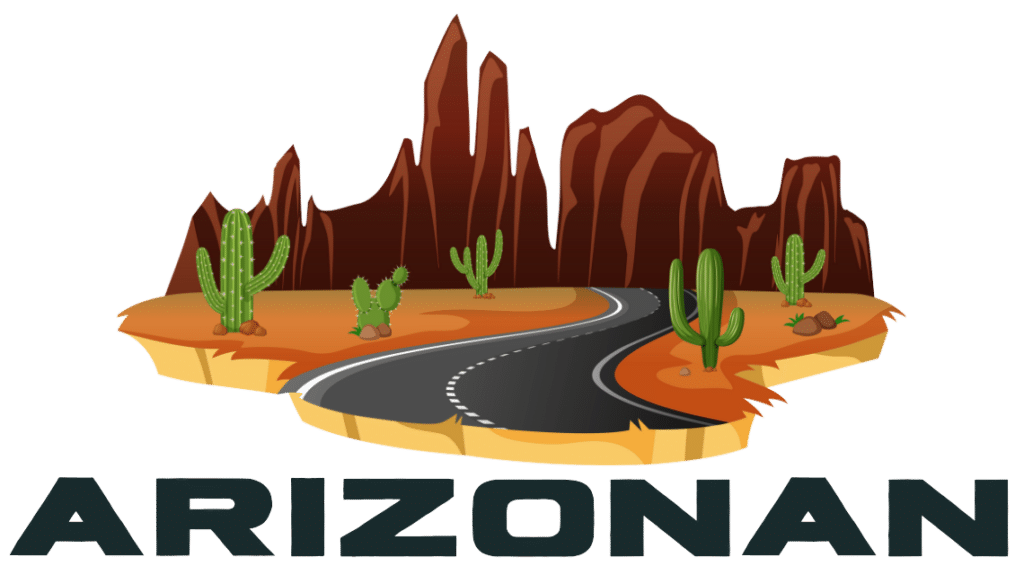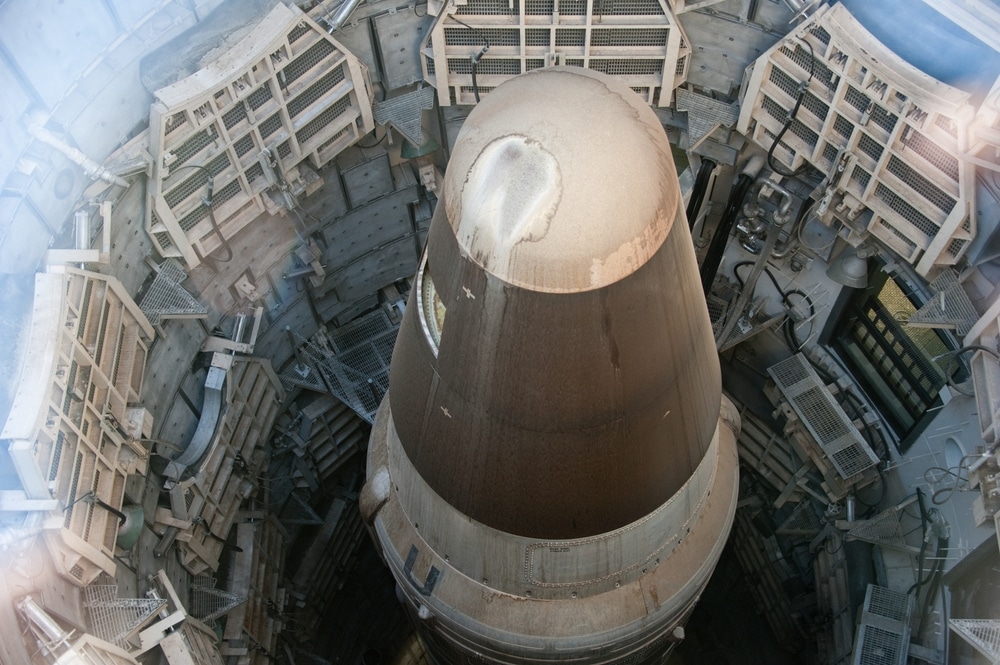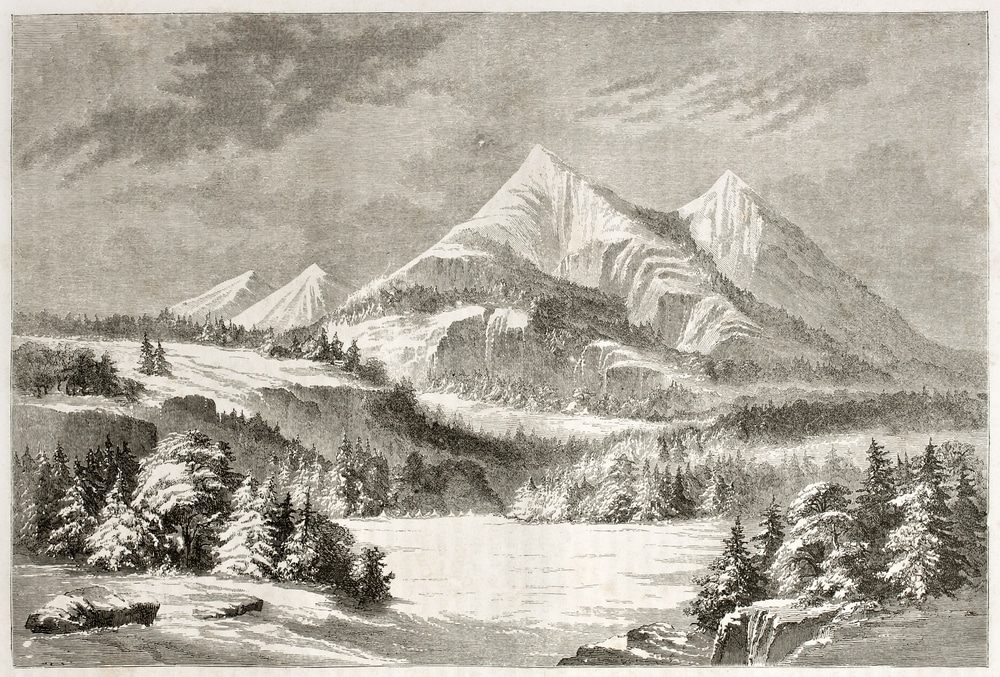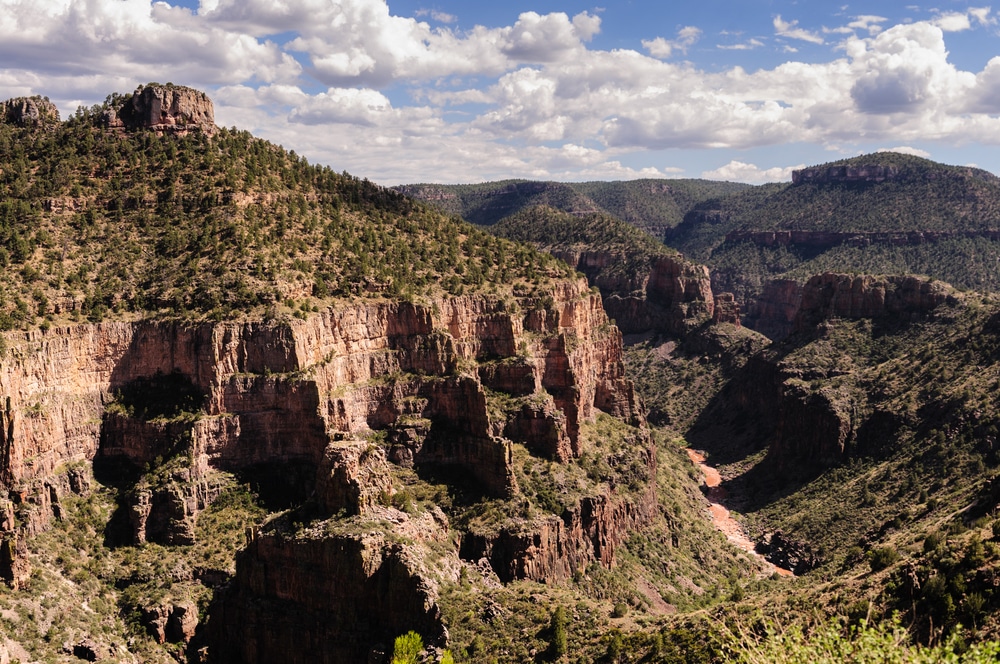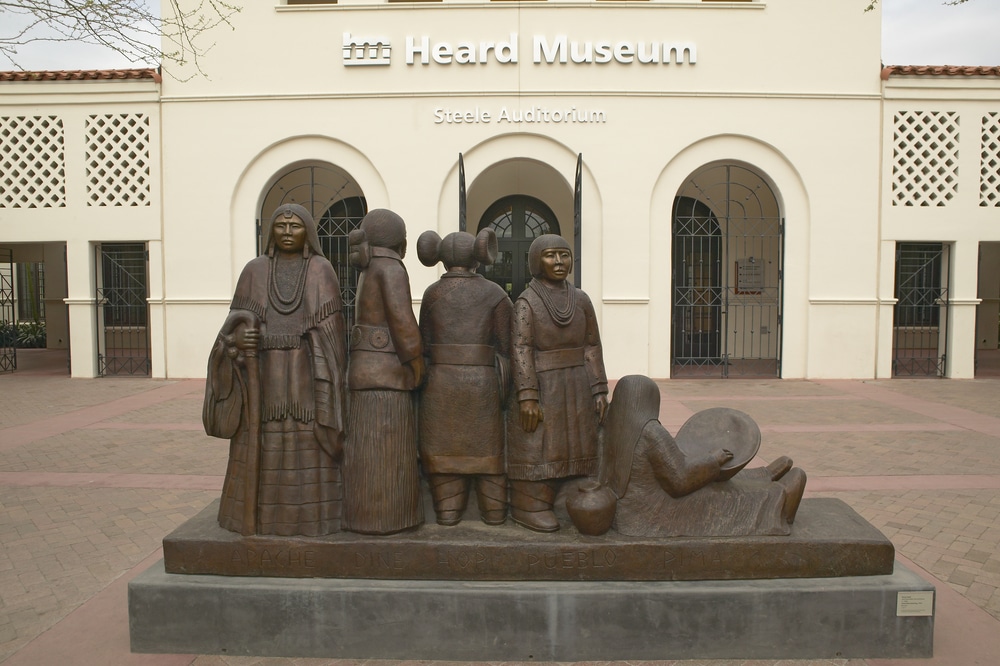Deep beneath the Arizona desert, 103 feet below ground, sat instruments of unimaginable destruction that for 25 years stood ready to launch at a moment’s notice. The Titan II Intercontinental Ballistic Missiles (ICBMs) housed in Arizona represented the most powerful weapons in America’s nuclear arsenal, each carrying a 9-megaton warhead—650 times more powerful than the bomb dropped on Hiroshima. Between 1963 and 1987, eighteen of these massive missiles waited in underground silos scattered across southern Arizona’s desert landscape, their crews maintaining constant vigilance during the height of the Cold War.
Arizona’s Strategic Importance
The selection of Arizona for Titan II deployment wasn’t accidental. The state’s sparse population, stable geology, and strategic inland location made it ideal for housing these weapons of deterrence. Beginning in 1960, the U.S. Air Force identified sites around Davis-Monthan Air Force Base in Tucson that met stringent criteria: they needed to be far from population centers, geologically stable enough to withstand nearby nuclear blasts, and positioned to reach targets across the globe.
The 390th Strategic Missile Wing, activated at Davis-Monthan in January 1962, oversaw the construction and operation of all eighteen Arizona sites. Each location was designated by a number (570-1 through 571-9), creating a ring of nuclear firepower around Tucson. The sites stretched from Oracle in the north to Nogales near the Mexican border, from Three Points in the west to Benson in the east. This dispersal pattern ensured that no single enemy strike could eliminate America’s retaliatory capability.
Construction of these complexes represented an engineering marvel of the early 1960s. Each site required excavating a launch duct 147 feet deep and 55 feet in diameter, along with three underground levels containing crew quarters, equipment rooms, and control centers. The massive concrete and steel structures were designed to withstand all but a direct nuclear hit. Workers poured over 20,000 cubic yards of concrete per site, reinforced with intricate rebar networks that made these among the most hardened structures ever built.
Life Underground: The Missile Crews
The human story of Arizona’s Titan II sites revolves around the thousands of Air Force personnel who staffed these facilities 24 hours a day, 365 days a year. Missile crews consisted of four members: a Missile Combat Crew Commander, Deputy Commander, Ballistic Missile Analyst Technician, and Missile Facilities Technician. These teams worked 24-hour alerts in the underground Launch Control Centers, prepared to execute launch procedures that thankfully never came.
Life in the silos followed strict routines. Crews descended through blast doors weighing thousands of pounds, passed through decontamination areas, and entered a world of recycled air, artificial light, and constant mechanical hums. The Launch Control Center, suspended on massive shock absorbers to survive nearby nuclear detonations, contained the equipment needed to monitor and launch the missile. Red safes held the authentication codes and launch keys that required two officers, separated by enough distance that one person couldn’t turn both simultaneously.
Former crew members describe the psychological challenges of their duty. Lieutenant Colonel George Mindling, who served at the Arizona sites, recalled: “You trained constantly for a mission you prayed would never come. Every drill, every checklist, every maintenance procedure carried the weight of preventing accidental war while maintaining readiness for intentional one.” The isolation, combined with the gravity of their responsibility, created unique bonds among crew members who shared this burden.
Technical Marvels and Terrible Power
The Titan II itself stood 103 feet tall and 10 feet in diameter, weighing 330,000 pounds when fully fueled. Unlike earlier missiles that required hours of fueling before launch, the Titan II used storable liquid propellants—Aerozine 50 and nitrogen tetroxide—allowing it to launch within 58 seconds of receiving valid launch orders. This quick-reaction capability made it America’s most responsive ICBM throughout its service life.
Each missile’s W-53 warhead could deliver its 9-megaton payload to targets over 6,000 miles away with remarkable accuracy for its era. The guidance system, revolutionary for the 1960s, used an inertial measurement unit that could navigate without external references, making it immune to enemy jamming. The missile’s two-stage design generated over 530,000 pounds of thrust at liftoff, enough to send its deadly cargo into space and back down onto targets anywhere in the Soviet Union or China.
The infrastructure supporting each missile was equally impressive. Massive diesel generators provided backup power, while sophisticated environmental control systems maintained precise temperature and humidity levels crucial for the missile’s sensitive components. Each site stored 195,000 gallons of liquid propellant in stainless steel tanks, requiring constant monitoring due to the corrosive nature of the chemicals. The propellants were hypergolic—igniting spontaneously on contact—making any leak potentially catastrophic.
Accidents and Near Misses
The Titan II program’s safety record included several serious incidents that highlighted the dangers of maintaining these weapons. While no Arizona sites experienced catastrophic accidents, crews trained extensively for emergencies based on incidents at other locations. The most serious occurred at sites in Arkansas, where a dropped socket wrench punctured a missile’s fuel tank in 1980, leading to an explosion that killed one airman and injured 21 others. In 1965, a fire at another Arkansas site killed 53 civilian workers.
Arizona’s sites had their own close calls. Fuel leaks, equipment malfunctions, and human errors created dangerous situations that crews handled with skill and courage. The toxic nature of the propellants meant that even minor leaks required personnel to don Rocket Fuel Handler’s Clothing—bulky suits that crews nicknamed “RFHCO suits.” These incidents reinforced the perpetual danger faced by those who maintained America’s nuclear deterrent.
Indigenous Perspectives and Land Use
The placement of Titan II sites across southern Arizona occurred on lands with deep Indigenous history. Several sites were located on or near traditional territories of the Tohono O’odham Nation and the Pascua Yaqui Tribe. The federal government’s use of eminent domain to acquire missile site properties often overlooked Indigenous connections to these lands, continuing a pattern of military installations disrupting Native communities.
Contemporary Indigenous leaders have reflected on this period with complexity. Former Tohono O’odham Nation Chairman Ned Norris Jr. noted: “Our lands have been used for various military purposes throughout history, often without meaningful consultation. The missile sites represented another layer of colonization, placing weapons of mass destruction on territories where our people have lived sustainably for thousands of years.”
Strategic Deterrence and Global Politics
Arizona’s Titan II missiles played a crucial role in American nuclear strategy during the most dangerous decades of the Cold War. The doctrine of Mutual Assured Destruction (MAD) relied on maintaining a credible threat of devastating retaliation to prevent enemy first strikes. The Titan II’s combination of quick launch capability, massive warhead, and hardened silos made it an ideal deterrent weapon.
During the Cuban Missile Crisis of October 1962, although Arizona’s sites were still under construction, the implications of their future presence influenced negotiations. By 1963, as the sites became operational, they figured prominently in strategic calculations. Soviet military planners identified the Tucson-area Titan II fields as priority targets, leading to an eerie balance where missiles aimed at Moscow from Arizona were themselves targeted by Soviet missiles in Siberia.
The signing of arms control treaties gradually reduced the Titan II’s strategic importance. The SALT I and SALT II agreements limited missile deployments, while improving accuracy of newer solid-fuel missiles like the Minuteman III made the liquid-fueled Titan II increasingly obsolete. President Ronald Reagan’s 1981 decision to phase out the Titan II reflected changing strategic needs and the aging system’s increasing maintenance costs and safety concerns.
Deactivation and Environmental Legacy
The deactivation of Arizona’s Titan II sites between 1982 and 1984 marked the end of an era. The complex process involved removing the warheads, draining and disposing of toxic propellants, extracting the missiles, and then destroying or repurposing the facilities. Most sites were imploded, their massive structures reduced to rubble and buried. The environmental cleanup continues decades later, as the toxic legacy of rocket fuel contamination persists at several locations.
The Air Force spent millions of dollars on environmental remediation, but contamination from propellant spills and leaks created long-lasting problems. Trichloroethylene (TCE), used as a degreasing agent, contaminated groundwater at multiple sites. The Environmental Protection Agency designated several former Titan II locations as Superfund sites, requiring extensive cleanup efforts that continue today. Local communities near former sites still monitor water quality and push for complete remediation.
Modern Connections and Preservation
Today, most of Arizona’s former Titan II sites are barely recognizable. Some were sold to private owners who converted them into unique properties—underground homes, storage facilities, or simply fenced-off relics. Urban expansion has brought housing developments close to several former sites, with many residents unaware of the nuclear history beneath nearby fields.
The physical remnants vary by location. At some sites, only concrete slabs and chain-link fences mark where billion-dollar weapons once stood ready. Others retain more substantial remains—blast doors, exhaust vents, and portions of underground structures that hint at their former purpose. Urban explorers and Cold War historians seek out these locations, though most remain on private property with restricted access.
Several organizations work to preserve this history. The 390th Memorial Museum at Davis-Monthan Air Force Base maintains archives and artifacts from the Titan II era. Veterans groups, particularly the Association of Air Force Missileers, collect oral histories and maintain databases of site information. These efforts ensure that future generations understand this unique chapter in Arizona’s history.
Contemporary Relevance
The legacy of Arizona’s Titan II sites resonates in current debates about nuclear weapons, national security, and environmental responsibility. As tensions between nuclear powers persist and new nations seek nuclear capabilities, the Cold War’s lessons remain relevant. The sites serve as physical reminders of humanity’s capacity for self-destruction and the delicate balance that prevented nuclear war.
For Arizona, the Titan II era represents a significant but often overlooked chapter in the state’s development. The influx of military personnel and defense spending contributed to population growth and economic development in southern Arizona. Communities that once hosted missile crews still feel the economic impact of their departure, while environmental contamination issues continue to affect property values and development plans near former sites.
Visit the History
While most former Titan II sites remain closed to public access, several locations offer opportunities to explore this Cold War legacy:
390th Memorial Museum
📍 Location: Davis-Monthan Air Force Base, Tucson, AZ
📞 Phone: (520) 228-3358
🌐 Website: 390smmg.davis-monthan.af.mil
🕒 Hours: By appointment only (base access required)
💰 Admission: Free
♿ Accessibility: Limited accessibility in some areas
Pima Air & Space Museum
📍 Address: 6000 E Valencia Rd, Tucson, AZ 85706
📞 Phone: (520) 574-0462
🌐 Website: pimaair.org
🕒 Hours: Daily 9 AM – 5 PM (last admission 3 PM)
💰 Admission: $20 adults, $17 seniors/military, $13 youth
♿ Accessibility: Fully accessible main exhibits
Former Site Locations (exterior viewing only)
- Oracle: Junction of AZ-77 and American Ave
- Three Points: Near Robles Junction, west of Tucson
- Benson: Southeast of town, off AZ-90
- Continental: East of I-19, south of Tucson
Additional Resources
For those interested in learning more about Arizona’s Titan II history, several resources provide deeper insights. “Command and Control” by Eric Schlosser details the Damascus accident and broader nuclear weapons safety issues. The Association of Air Force Missileers website (afmissileers.org) maintains extensive databases and personal accounts. The National Security Archive at George Washington University has declassified numerous documents related to the Titan II program available online.
Local historical societies in communities that hosted missile sites often maintain archives and occasional exhibitions. The Arizona Historical Society in Tucson holds photographs and documents from the construction era, while the Udall Center for Studies in Public Policy has oral history projects featuring missile crew veterans.
